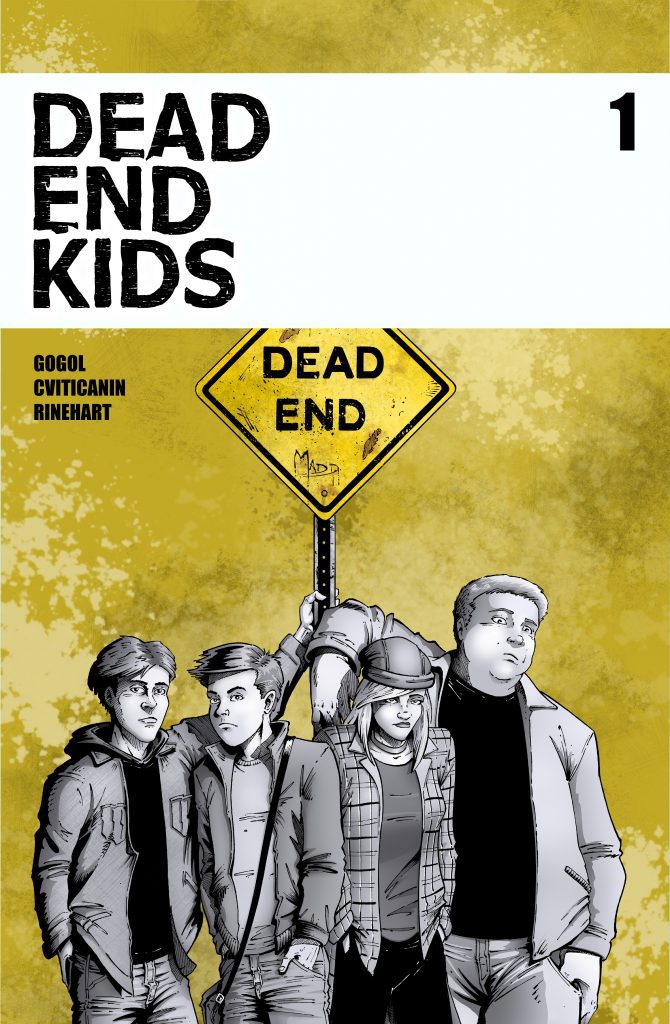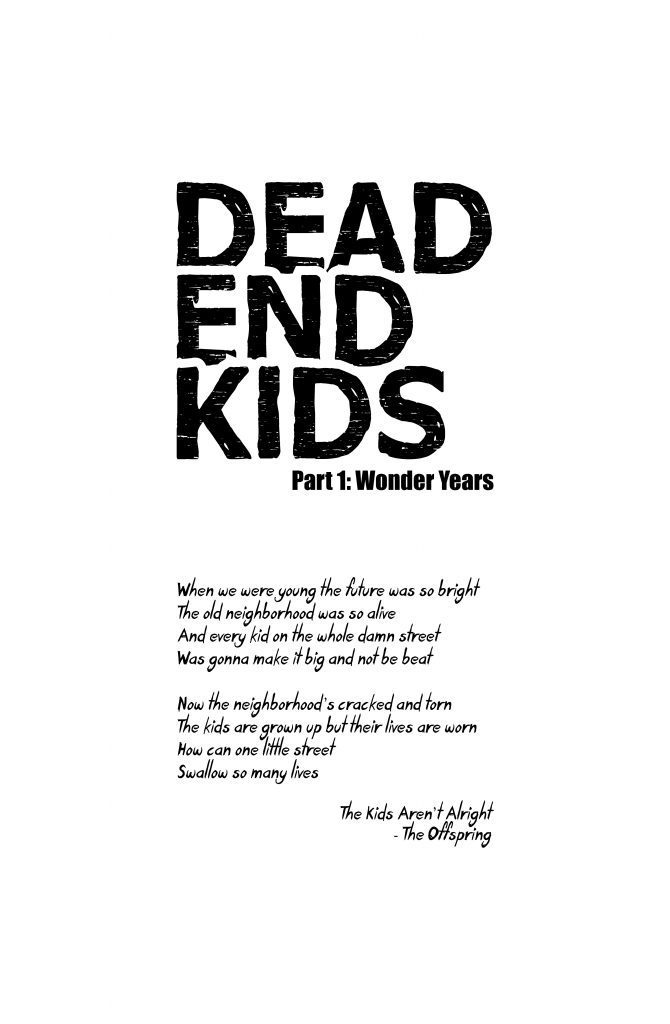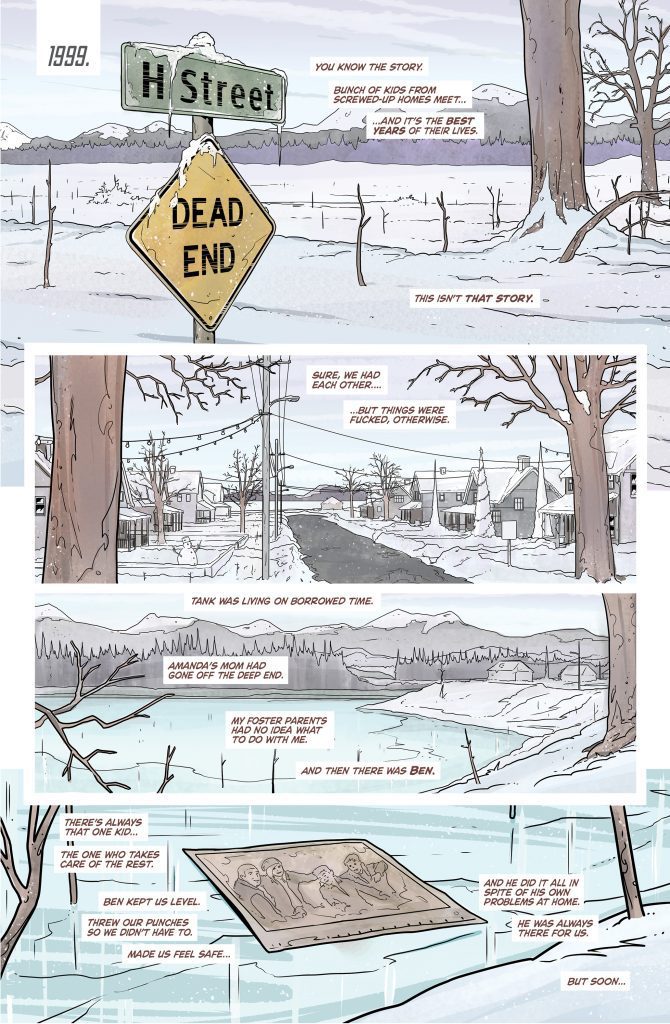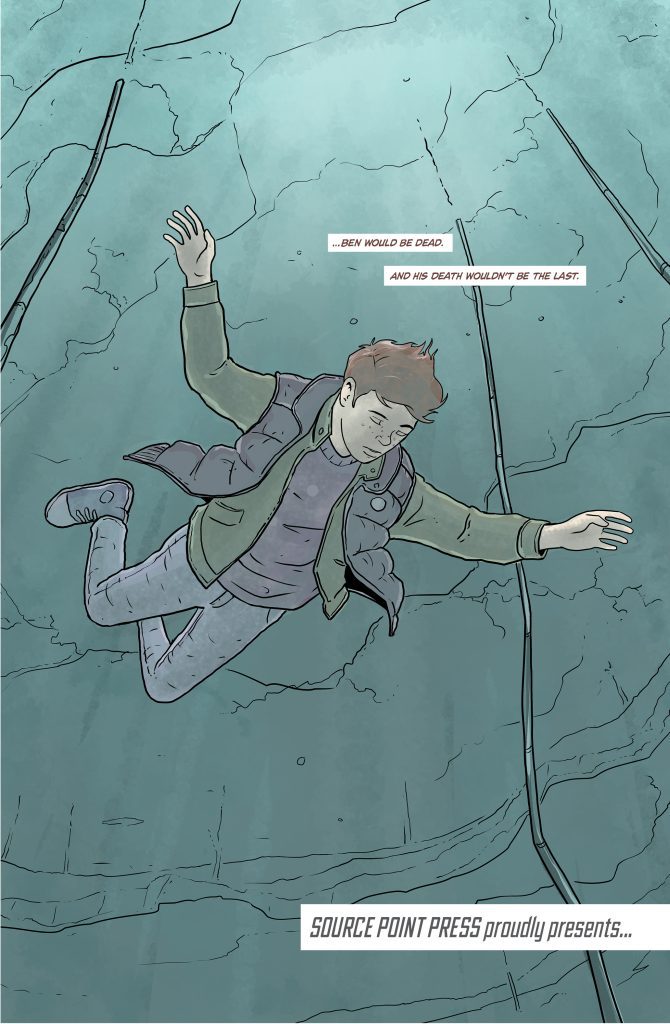
The Kids Aren’t Alright: Interview with Dead End Kids Creator Frank Gogol
The world of comic books is so vast and diverse. From superheroes to space cats, from television series continuations to heroes in a half shell, the landscape of the comic book industry is amazing right now, if you know where to look. Sure, the big two publishers like Marvel and DC put out amazing titles, as does Image, Dark Horse, BOOM!, and the other well known publishers. But when you look deeper, and dive into the world of creator owned independent books, you will find some books that just grab hold and don’t let go.
Case in point: Dead End Kids by Frank Gogol, Nenad Cviticanin, and Sean Rinehart, the team behind the 2018 hit, GRIEF. Published by Source Point Press, the three issue mini-series kicks off in July and is available for pre-order at your local comic shop right now.
Set in the late-90s, this coming-of-age murder mystery sees a band of misfit kids — Murphy, Amanda, and Tank — trying to solve their friend Ben’s murder all while trying not to get killed themselves. And unlike a The Hardy Boys novel, not everyone makes it out alive.
I was given an opportunity to speak to series creator Frank Gogol about his career, the upcoming series, as well as some news on a very cool summer convention exclusive cover dropping in July and where to get it. Also, you can see why his characters might seem relatable to you as well, as they were for me. I was able to check out the book in advance, and let me say, this is a ride you want to be on board for from the start.
Pastrami Nation: What is your background for people who may be experiencing your work for the first time?
Frank Gogol: I think this is probably true of a lot of people. I only wrote my first comic script about three years ago and just had my first book, GRIEF, published about a year ago–so I’m still getting my name out there.
Regarding the work, I generally draw on my life experience to tell meaningful character-driven stories. I did not have a fantastic life growing up and I pull from that well of experience to write a lot of work.
GRIEF, for instance, is a short story collection that explores the five stages of the grieving process through genre stories, and much of what’s in the collection is based on things that have happened in my life or in the lives of people who close to me, but with monsters, aliens, and superheroes.
So, that’s kind of a high-level view of my writing style the kinds of things that influence it.
PN: What was the inspiration for Dead End Kids?
FG: It was two things, really.
I’m a huge fan of coming-of-age stories. IT. Stand By Me. The Sandlot. The Breakfast Club. All of those stories about kids going through stuff and finding a family in their friends really speak to me. So, I wanted to take a stab at telling that kind of story, but my version of it.
About a year and a half ago, I turned 30 and around that time, I started getting really nostalgic for my younger years in the late 90s and early 2000s. I started remembering things like hanging out outside with friends, building clubhouses in the woods, and being in before the streetlights came on–all of those sort of best-years-of-your-life kind of things.
But then started to remember everything else from my childhood. Things, for me, weren’t great at home. My mother and step-father struggled on and off with drug addiction and home didn’t always feel like the most welcoming or safe place, and that’s a big part of why I’d be outside with my friends so often. Similarly, my friends’ home lives weren’t great, but we always had each other. So I wanted to write about that.
But the one thing that’s always irked me about coming-of-age stories is that the structure tends to go: a kid has a problem, he meets some other kids, they have a great summer and the first kid learns to deal with his issue. Then, you find that at the end of the summer, those kids all parted ways and grew up and grew apart–and this just wasn’t my experience growing up.
I’m still very much good friends with the kids I grew up with. One of them is the Best Man in my wedding later this year. So, I wanted to write a coming-of-age story that explored the idea of “best friends means best friends forever” while tackling the idea of childhood traumas and how they define us as we get older.
PN: Why Source Point Press to publish it through?
FG: Source Point Press was the publisher on my first book last year, GRIEF, and they’ve been so incredibly good to me that I, honestly, couldn’t imagine bringing this book anywhere else.
For anyone who’s not familiar with Source Point Press, stop what you’re doing right now and go check out books like Ogre by Bob Salley, Norah by Kasey Pierce, and Franklin and Ghost by Garrett Gunn. Some of the best comics being made are coming out of SPP and Dead End Kids is just the latest in a long line that’s got a mega-bright future.
PN: Norah is quite amazing, just to add to that. The art is amazing in Dead End Kids, how did you connect with the artist?
FG: The art and color are by Nenad Cviticanin and the letters are by Sean Rinehart, both of whom I worked with on GRIEF, so I’ve been working with these guys for years at this point.
Sean and I connected via Comics Experience, the comics school that we both came up through and, if I’m remembering correctly, I cold-reached out to Nenad.
Interestingly enough, they were collaborators on the very first comic story I ever made and it’s been pretty wild and very gratifying to see how we’ve all grown as creators since then.
I’d enjoyed working with Sean and Nenad so much that I think I subconsciously wrote Dead End Kids with them in mind and hope that they’d be on board. We have really fantastic creative synergy and it shows really well in Dead End Kids.
PN: The dialogue feels so natural, it is rare for me to see dialogue this true in comics. What’s your secret?
FG: That’s super nice of you to say! But if you were to ask me, I’d say my dialogue is still very much a work in progress.
In terms of my process, I think there are a couple of things that help me when it comes to dialogue. The first being that I revise. Revision is pretty tedious and a lot of creators are excited to get work finished and out so they don’t necessarily take the time to do it properly or maybe even at all, but I try to have some discipline in that regard.
I’ll always write what I call a vomit draft–just so I have the a sort of function version of the whole. The dialogue and the panels may not be refined, but they perform the function that they’re supposed to. Then, I go through one page at a time and turn things around and mix them up until I have the most entertaining version of that page I can create. The same is true for dialogue. I read the lines out loud and rewrite them until what I’m reading sounds natural and interesting to me.
PN: The book is dark and promises to get darker. What is your goal with DEK?
FG: At the surface, this book is a who-done-it mystery. It’s about three kids in the late 90’s trying to solve their friend’s murder.
But at its core, It’s about these four kids who all have these terrible home lives but who find one another and in one another find some semblance of stability and what happens to the stability when one of the is murdered.
Ultimately, Dead End Kids is an exploration of childhood traumas and how much those traumas determine who we become and how much control we have over that. So, if I’ve done my part, some of these ideas will resonate with readers. PN: How can people learn more about DEK, how can they order it, how can they find info online, also any upcoming conventions fans can find you at?
PN: How can people learn more about DEK, how can they order it, how can they find info online, also any upcoming conventions fans can find you at?
FG: If anyone wants to know more about the book (or me), they should definitely give me a follow on Instagram or Twitter or even my personal Facebook page. I know that sounds really self-promotional, but the truth is I enjoy engaging with readers and fans and it’s something I wish more creators did. There’s definitely something to that grassroots approach to making comics, and I’m all about it.
Dead End Kids #1 drops on July 24th. Initial preorders just closed on issue one (and the orders were really, really strong), but I spoke with the publisher and the print run will exceed those order number by a bit, so anyone who’s interested in the book can get a first print copy through reorders still.
The Diamond order code for Dead End Kids #1 is MAY191908
Dead End Kids #2 is currently in Previews and can be ordered with the Diamond order code JUN191916. Issue two is something special and is definitely my favorite thing that I’ve ever written, so I hope people will check it out.
In terms of conventions, I’ve got Ace Comic Con in Seattle at the end of June and then San Diego Comic Con in July. For those readers who are heading to SDCC and who are collectors, we’ll have a very cool SDCC-exclusive cover for Dead End Kids #1 by Tomb Raider artist Phil Sevy ahead of the book’s release.
Dead End Kids #1 will hit comics shops on Wednesday, July 24. Review coming soon, and you will not want to miss this!
Nolan P. Smith is the Editor and Co-Founder of Pastrami Nation. Being a reporter for the past ten years, he has worked for a variety of media outlets, from newsprint to the ever-evolving internet platform. Residing in Victorville, CA, writing has always been a major aspect of his life. You can usually find him at comic book conventions, looking for more amazing books to dive into, or at the gym at odd times of the night. You can follow him on Facebook, Twitter @nolanpsmith and Instagram @kakooee.

